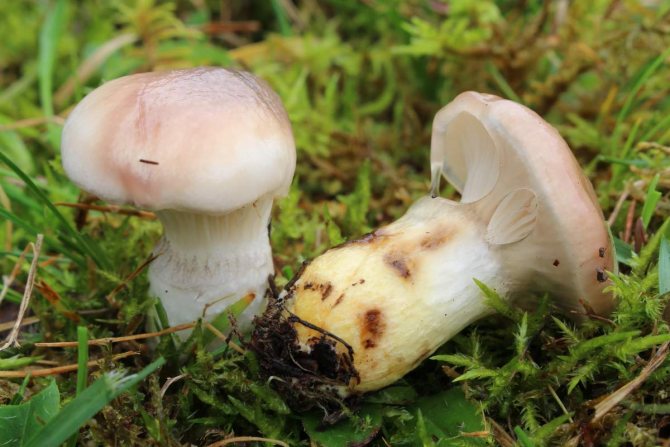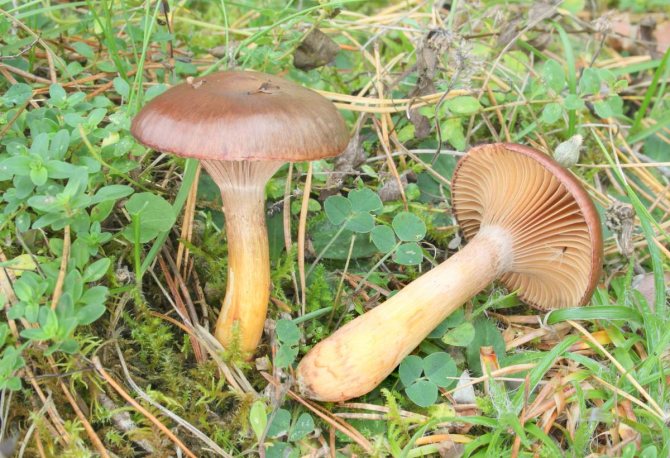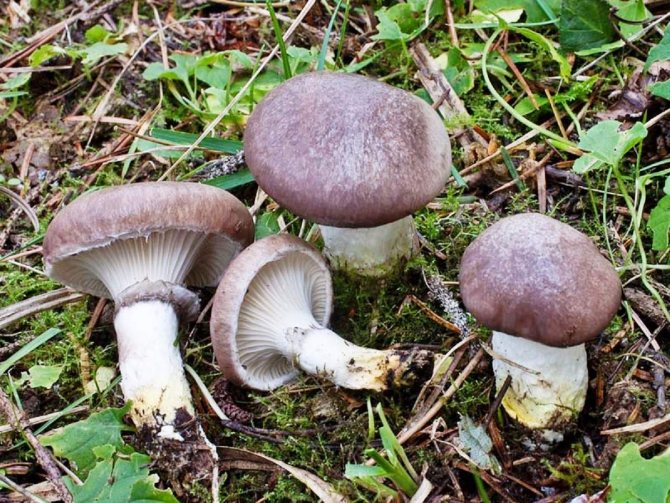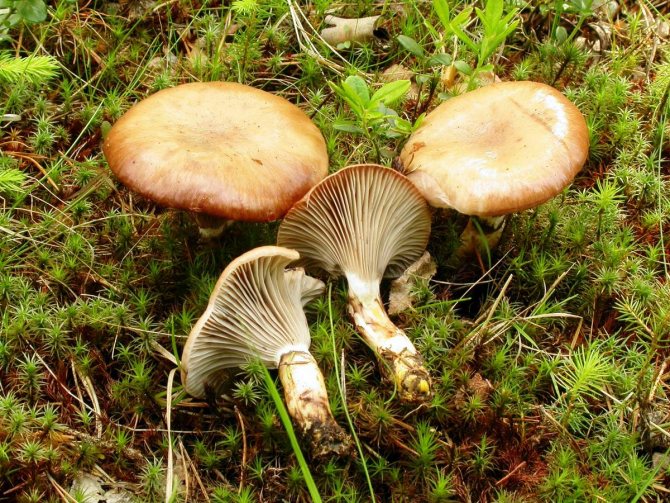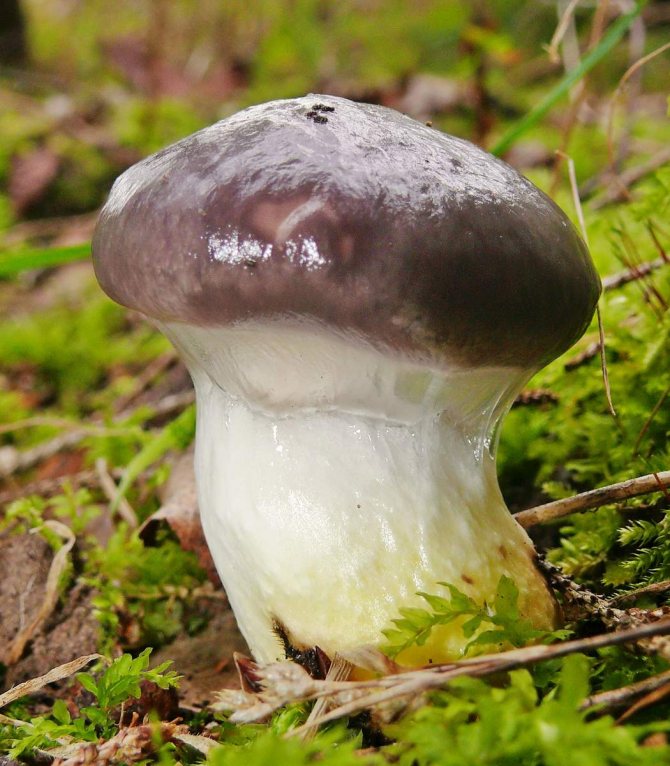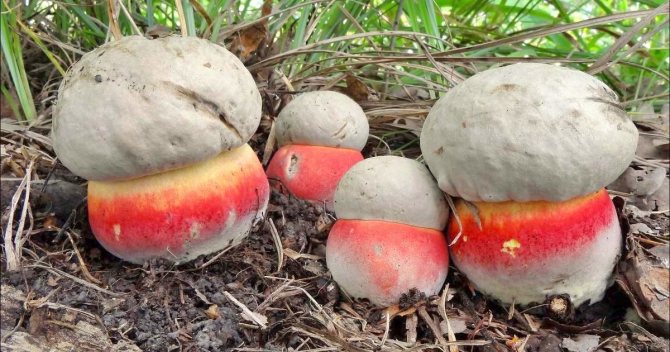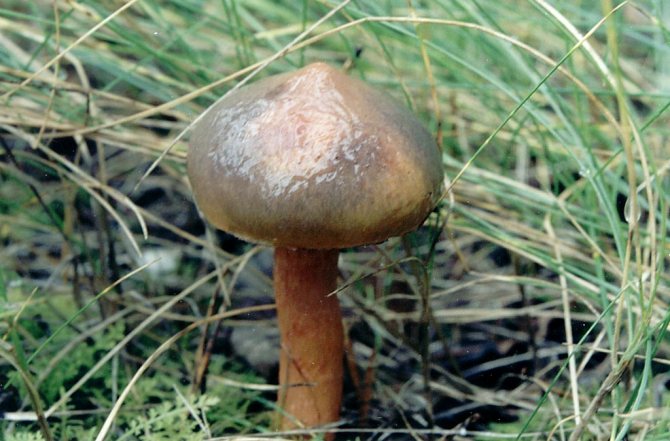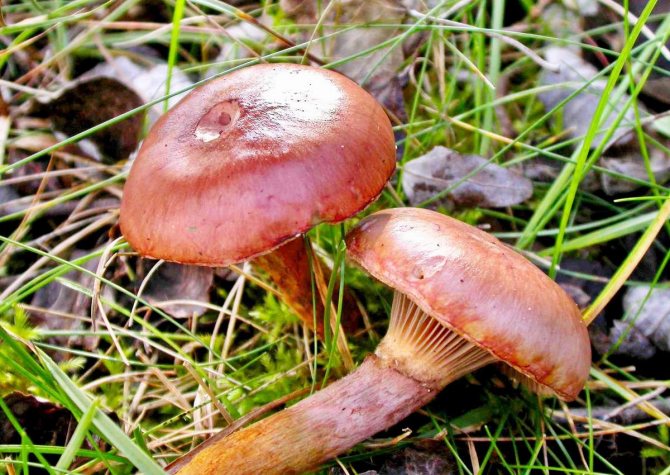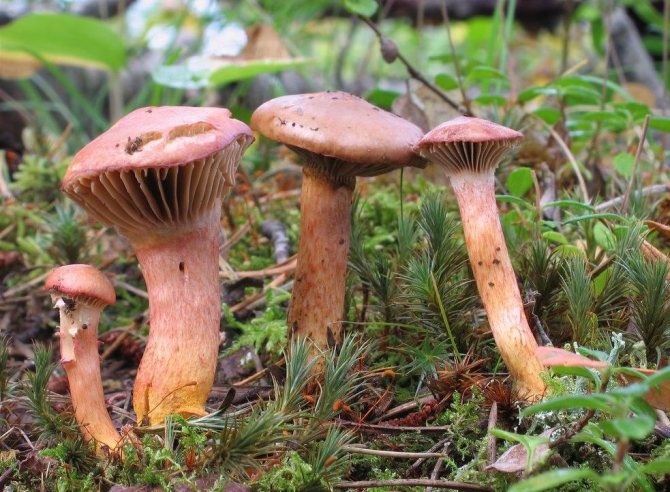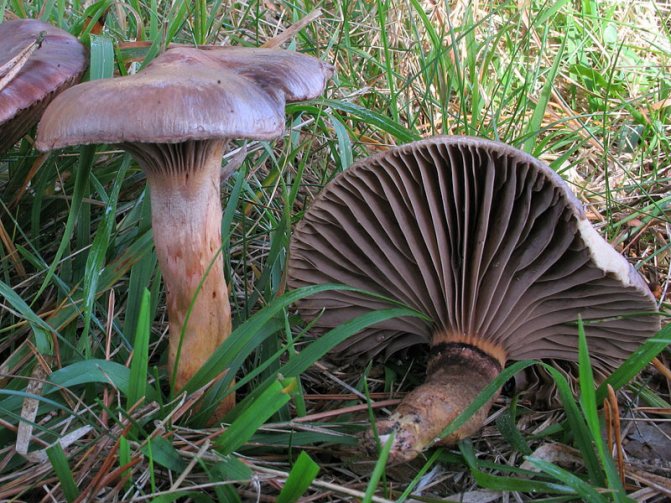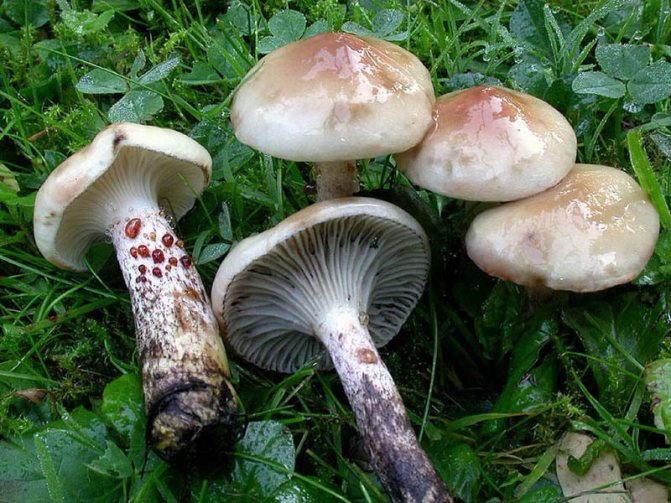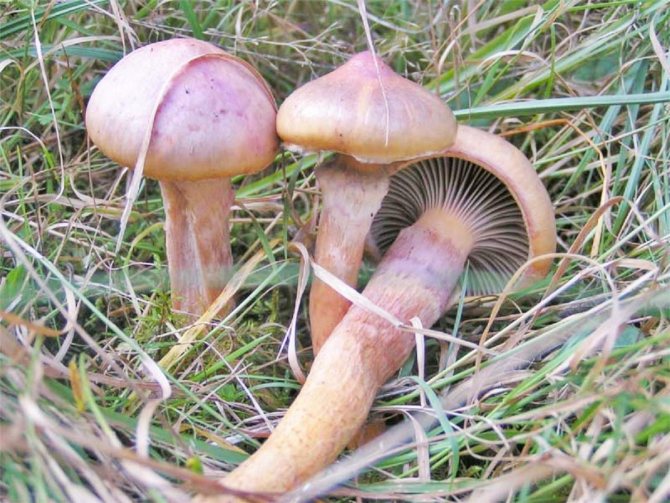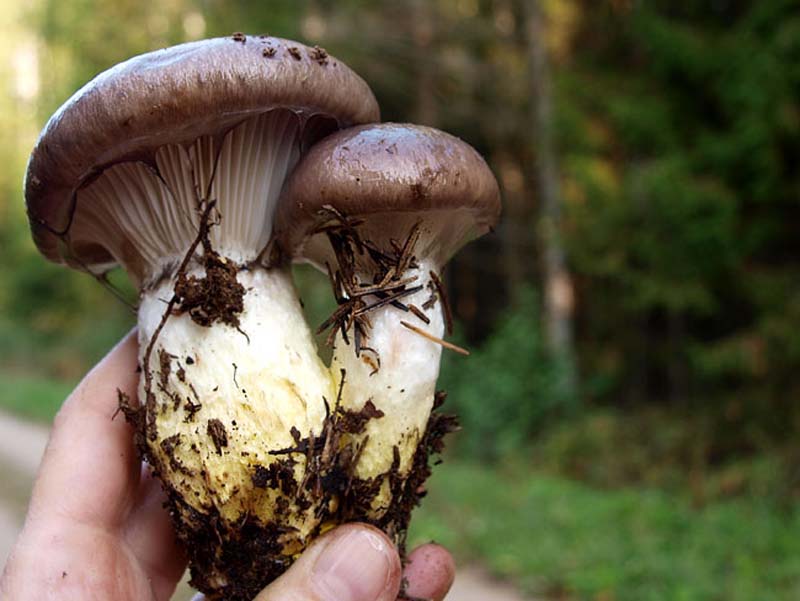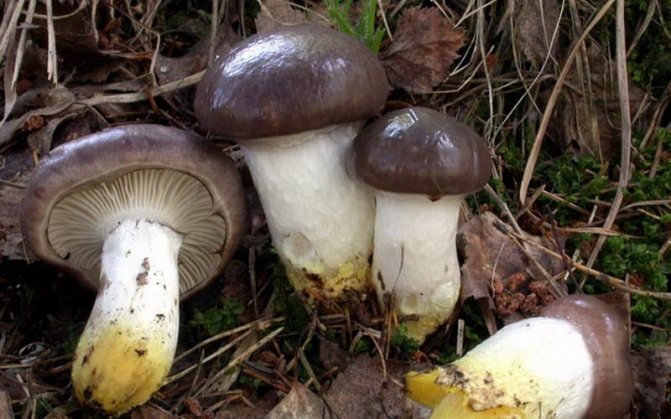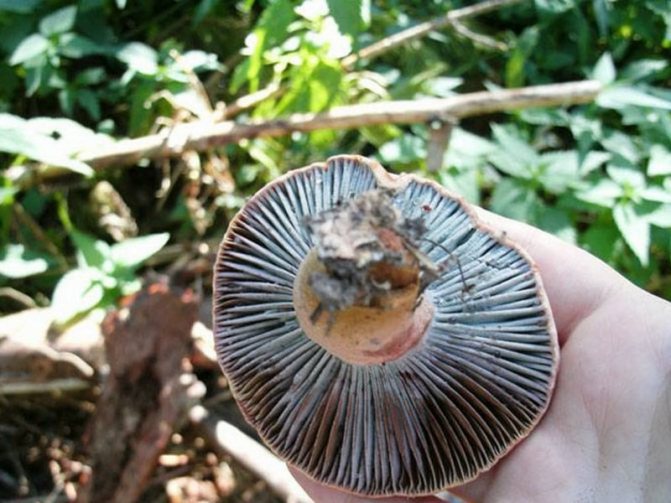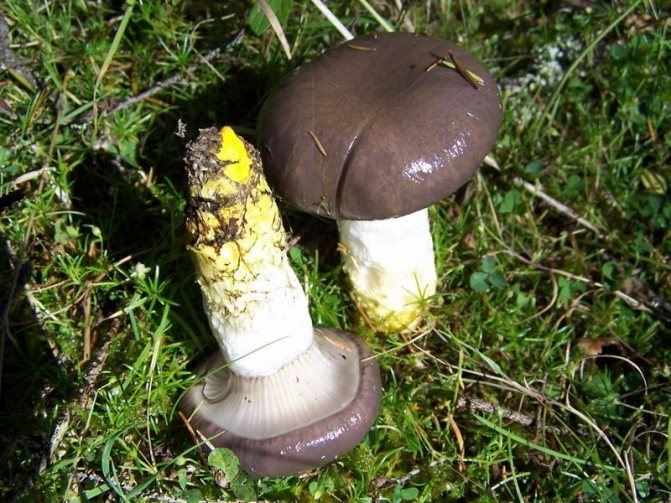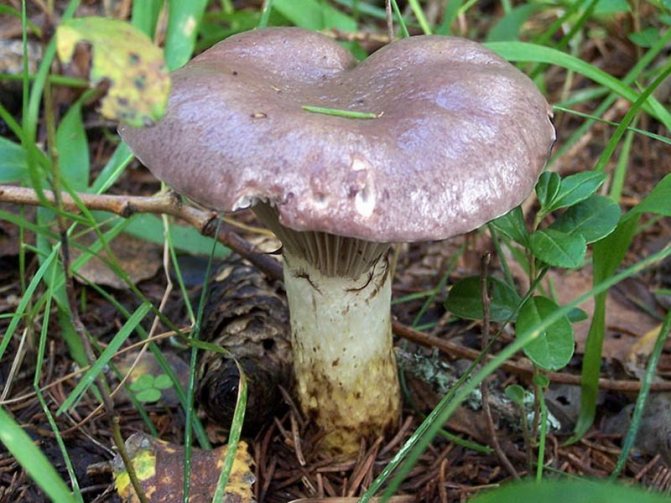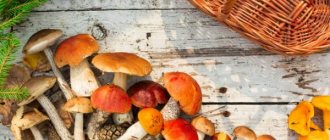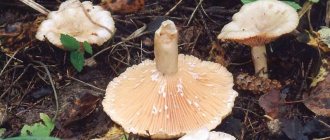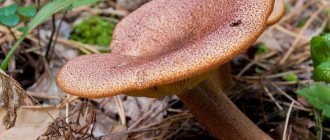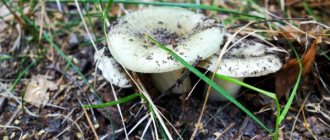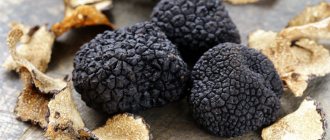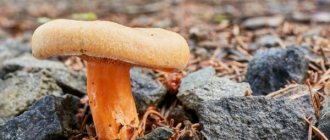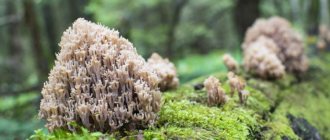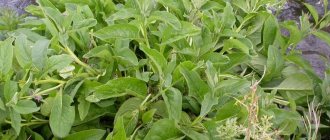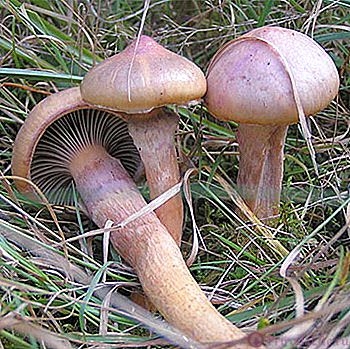
The mokruha mushroom belongs to the fourth category of edible mushrooms, that is, it is suitable for consumption after preliminary boiling. It can be salted and pickled, and can also be used as an ingredient in sauces.
In this article, your attention will be offered a photo and description of the most common types of mokruha mushroom: spruce, pink and purple. You will also be able to familiarize yourself with the etymology of the name of the mushroom, find out where and when it grows, see a photo of the mokruha mushroom in its natural habitat.
Description of the mushroom
Mokruha is a conditionally edible mushroom that belongs to the fourth category of edible mushrooms. That is, in order to eat it, the mushroom must first be soaked and then boiled. Some housewives use it as an addition to various sauces, dried, salted and pickled.
The mokrukh family can be subdivided into two genera, called chroogomphus (lat.Chroogomphus) and homphidius (lat.Gomphidius). A distinctive feature of these mushrooms is to form a wet, slimy film on the cap. These gifts of the forest are always slippery to the touch. It is this characteristic feature that confuses many mushroom pickers.
Mokrukh can grow both singly and in small families. The active growth of representatives of this family is observed from the beginning or mid-July until the first frost.

How to collect and store
Spruce bark grows from July to the end of October (less often it can be found in early November) in forests with conifers (mainly spruce), sometimes it is found in mixed forests. The highest fruiting occurs from mid-August to the end of the first autumn month. A lot of wet fur comes out after a lot of rainfall.
The mushroom is quite common in the central and northern regions of Russia. It grows next to a spruce, in some cases - with a pine. It is found both in the grass under sunlight and in dark places among the moss. Spruce moss grow in groups. They can often be found in the vicinity of boletus.
A significant plus is the absence of poisonous twins in the slug. In rare cases, it can be confused with other similar mushrooms that are also edible:
- Mokruha is spotted. Its flesh has a red tint at the break. There are dark spots on the cap, and the spore powder has an olive color.
- The mucous is purple. The pulp of the mushroom has an orange-brown hue, its plates are dark purple.
- Butterlets. Mokrukhs with dark caps resemble ordinary boletus, but the latter have no plates.
It is important to remember the following rules before heading to the forest for mokrukh:
- The mushroom must be carefully cut with a knife so as not to damage the mycelium.
- It is better to collect the mushrooms in a separate basket, as they are capable of dyeing nearby mushrooms purple. In general, the entire crop must be harvested separately by type.
- Do not collect too old copies. They may turn out to be rotten. You need to check the mushroom for worminess.
- It is necessary to collect mokruh early in the morning, when they have not yet wasted all the moisture. So the product retains more useful components.
- A good harvest can be obtained after a warm rain that passed the previous evening. After dry weather, it is best not to collect slugs.
It is advisable to process the prey on the day of harvest, so the mushrooms will not deteriorate and retain their useful properties. It is necessary to sort out mokrukh, clean them of dirt, earth and needles. Selected mushrooms are harvested in a cool place. You can freeze slugs. In this form, they are stored for 10-12 months. Before that, they must first be boiled.
The truth about slippery mushrooms
In terms of taste, mokruhs are largely inferior to more expensive representatives of this kingdom. Of course, they are not as tasty as white or champignons. However, in terms of the content of a large amount of nutrients and antibacterial components, they are ahead of all types of mushrooms found in the middle zone of our country. Some biologists and botanists call the mokruh family a storehouse of proteins, carbohydrates, amino acids and consider them indispensable in medical nutrition. By the way, during cooking, the mokruha mushroom turns black.
Possible contraindications
Taking mokruha as food or additives to medicines and cosmetics does not cause complications. A purple shade of color helps not to confuse purple moss with any other poisonous mushroom. On the cut, this type of mushroom always takes on a pink or red color. However, even the seemingly harmless mushroom can have negative consequences on the human body. This can happen if the mushrooms were collected in a forest near highways, within a large city, near industrial enterprises or landfills. Such mushrooms should not be collected and eaten.
For some people, mushroom food may be too heavy for their bodies to digest. These groups of people include children, the elderly and people suffering from diseases of the gastrointestinal tract. Chitin, which mushrooms contain, is practically not assimilated in an unprepared child's body.
spruce moss - description of where it grows, the toxicity of the mushroom
Where are mokruhas found?
In Russia, the mokruha mushroom is found in regions with a temperate climate. Here you can find six of them. So, purple, pink or pine mokruha chose pine forests for their existence. In symbiosis with firs, pines and cedars, a felt mushroom grows. Slender or spotted wet trees prefer to live under larch trees. The spruce mushroom found its refuge under the spruce.
Cooking and harvesting these plants does not require special efforts from the hostess and the presence of special knowledge in the field of cooking. Therefore, many experienced mushroom pickers are happy to collect them. According to connoisseurs of mokruha, you can clean the mushroom immediately after cutting. It doesn't take long and keeps other fungi from getting dirty with the sticky mucus.
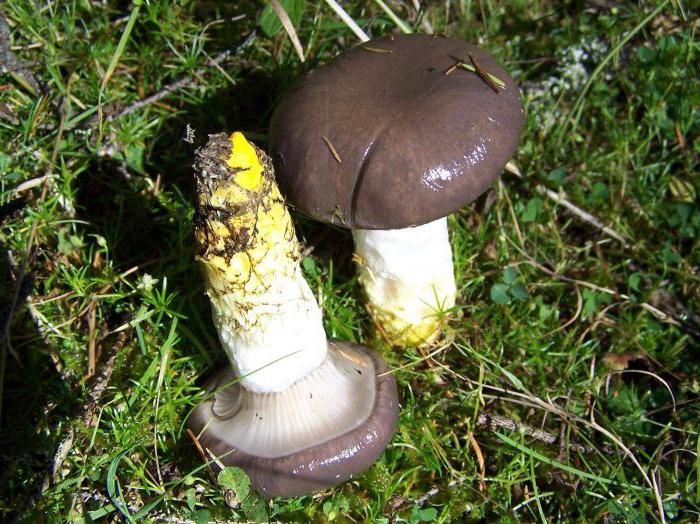

Interesting facts about purple moss
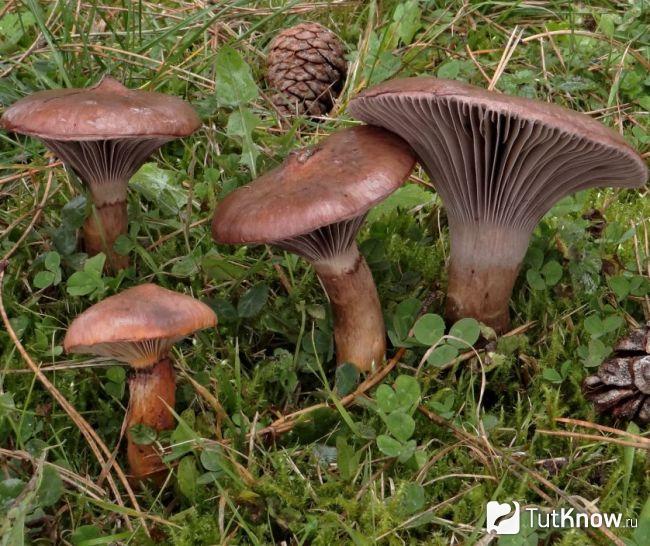

The German botanist Jacob Schaeffer first became interested in this mushroom, who at the end of the 18th century (1774) ranked his discovery as a type of champignon. Such a comparison has nothing to do with the appearance of wet fur, because it acquires such a color when notched or heat treated.
Some researchers of the forest spaces still consider this mushroom a product of the fourth category. For all his impartial appearance, he is a rather useful gift that nature has presented to us. Its repulsive appearance did not prevent many peoples of the world from using the mushroom as a means of fighting viral and skin diseases.
The favorite location of purple moss is near pine and birch, where it reproduces quite actively through pores. In this fact, there is little interesting information, but at the same time, the yellowleg does not have imitators, under which the inedible or life-threatening mushrooms hide. It is impossible to poison them if it does not grow near toxic enterprises.
It should also be remembered that removing the film from the cap is a prerequisite for using this product for food. Otherwise, even a person who is not picky about food will not be able to eat it.
Watch a video about purple mokruha:
The composition of purple moss is more likely to speak about the advantages of this mushroom than about its disadvantages. However, before eating something, you need to think about the consequences of such an action. It is better to enjoy a product that tastes good after consulting a doctor.
Notable features
It doesn't matter where you met the mokruha mushroom - an experienced mushroom picker will never confuse it with anything. However, these mushrooms still differ among themselves. They may have dissimilar shapes and different color shades, or may or may not have a specific odor. It is worth noting that, depending on the type, the taste of this type of mushroom also differs significantly. It is believed that the pine family members have the most exquisite taste.
Difference from similar species
Even for an inexperienced mushroom picker, it will not be difficult to distinguish spruce moss from another mushroom, since there are practically no poisonous analogues. The only similar species is spotted moss.
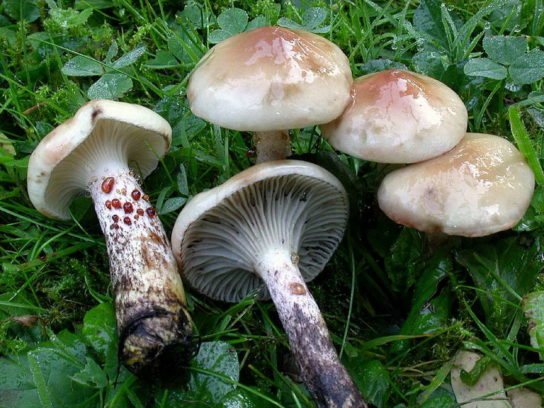

But, as the name suggests, it has characteristic spots on the cap and a reddish color at the cut. Spruce moss does not change color on the cut, which is a distinctive feature of this type of mushroom. Spruce also has a slight resemblance to boletus, but they can be easily distinguished by the presence of plates in the wet fur.
What are similar and what are not similar
For example, spruce moss can have a dry or rather sticky rather than slimy film. The color of the cap can be grayish or bluish, or it can be dirty brown, without any spots. In young mushrooms, the cap is convex, but over time it acquires a more outstretched shape. On the inside of the caps of these mushrooms there are plates. A high leg with a slight swelling in the middle and a characteristic wide ring, also covered with mucus - these characteristics are a kind of hallmark of mokruh. The surface of the mushroom leg is smooth and moist, at the very bottom it is bright yellow, but whitens closer to the cap. The mushroom pulp is firm and fleshy, tender and almost white. The smell is almost completely absent. Usually these mushrooms grow in small families.
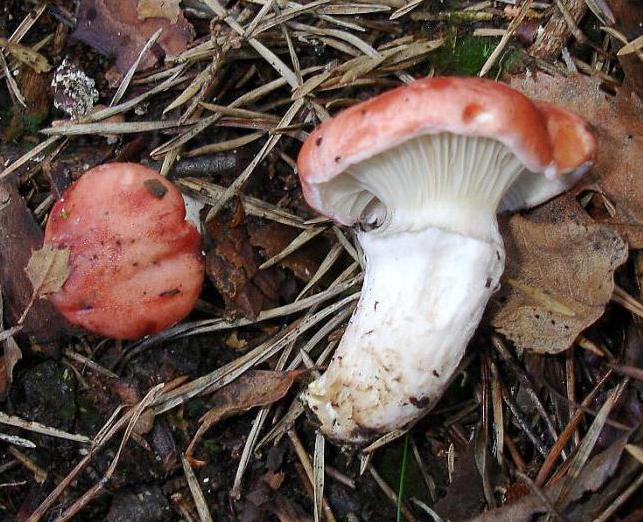

The purple moss mushroom has a fleshy, convex-conical cap with slightly curved edges. But the older the mushroom gets, the flatter the cap becomes. Color - orange-brown or copper-red. It has a sticky mucous film on the surface. On dry, sunny days, the wet layer dries up, and then the cap acquires a gloss. On the reverse side of the cap, the plates descend to a low, thin stem. If the leg is broken, the flesh begins to turn yellow at the break. The flesh of the mushroom itself is colored saffron, and with slight pressure it becomes wine-red. Has a pleasant, slightly sweet smell.
Collection rules
In order to avoid negative consequences, it is important to adhere to the basic rules for collecting mokruha:
- The cut of the mushroom must be done in the middle of the leg, then cover the mycelium with needles.
- It is strongly not recommended to collect moss near highways, military training grounds or chemical plants.
- It is best to give preference to young specimens, since old mushrooms tend to accumulate toxic substances in themselves.
- It is equally important to check the fruiting body for the absence of worminess.
- Immediately after harvesting, it is important to heat the moss: under room temperature conditions, the mushrooms quickly deteriorate.
- Store in the refrigerator for up to 24 hours. At the same time, the fruit bodies should be kept in earthenware or enameled dishes.
Other members of the family
Pink moss stands out from the family of these mushrooms. Her bright pink hat, slightly burnt in the center, attracts and at the same time frightens off many mushroom pickers.Young pink mushrooms have a noticeably convex cap, but over time it becomes almost flat, while its edges begin to curl upward. The surface is slimy, sticky in wet weather. Wide plates smoothly descend to a short cylindrical leg, on which there is a mucous ring. The flesh of this mushroom is very light, fleshy and soft. When cooked, it turns black. There is almost no smell.
Mokruha slender got its name because of its size and shape. It looks very much like purple moss, but differs in a higher strong leg and a small cap with dark spots. It has rare plates descending to the stem. However, this is a completely different species, so they cannot be confused.
Felt mushroom is another member of the mokruh family. Its other names are felt yellowfoot and swiss moss. The small cap is usually orange-brown in color and has a felt or scaly structure. In dry weather, it is mostly dry, but after rain it becomes slimy. It has dense pale pink plates that fall down to a thin, often curved stem. With age, these plates can turn black. The stem of the mushroom is not high, it can reach 8 cm in height, at the base it most often narrows slightly. Usually the color of the leg is identical to the color of the cap. The fields of the cap of young mushrooms can be connected to the stem with a light, dry, fibrous tissue. This species is widespread in upland coniferous forests and cedars.


False doubles
Purple mokruha has no poisonous and dangerous counterparts. But in the absence of experience, it can be quite confused with edible mushrooms of the same type.
Spruce moss
This mushroom is very similar in structure to the purple variety. His hat is also medium in size, at first convex, and then outstretched, the leg reaches 12 cm in height and 2.5 cm in girth. But you can distinguish a spruce mushroom by its color shade, its hat is gray-gray or gray-violet, it does not have an unusual wine tint.
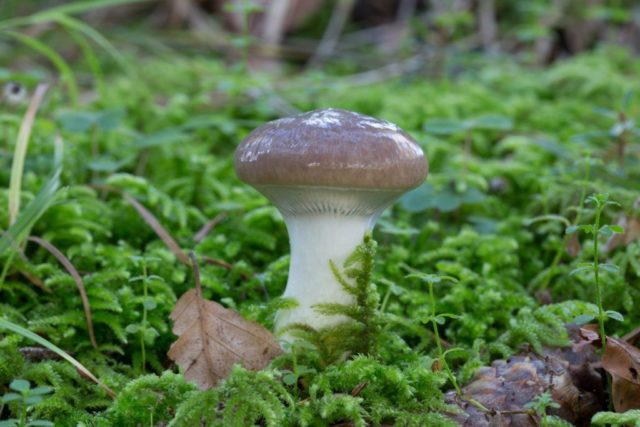

Spruce moss grows, in accordance with its name, mainly in spruce forests and forms a symbiosis with spruces. You can eat it, but its taste is quite average.
Pink moss
Another variety similar to the photo of pine moss is pink moss. The mushrooms are united by similar features in the structure - strong cylindrical legs, narrowed in the lower part, and convex at first, and later spread caps. But the differences between the varieties are noticeable - pink moss is much smaller and rarely exceeds 5 cm in diameter. In addition, its cap is bright pink at a young age, in old fruiting bodies - with a slight yellowish tinge and dark brown spots.


Pink moss grow in coniferous forests, mainly in the mountains, and are often found next to goats. The fungus is not widespread and is quite rare. Like purple moss, it belongs to the edible category, but has a mediocre taste and needs to be peeled before consumption.
How to cook mushrooms
Mokrukha, like any other types of mushrooms, is soaked for several minutes, the top sticky layer is removed from the entire surface and washed thoroughly. Since these mushrooms are conditionally edible, they must be boiled. Many housewives claim that after preliminary processing, these gifts of the forest must be placed in salted water, brought to a boil and cooked over low heat for 15-30 minutes. However, in fact, long-term cooking of wet moss is undesirable. From this, their flesh becomes tough and fibrous. During heat treatment, the color of the mushrooms can change significantly: from a light pulp it turns dark purple, almost black.
They are not very good as an independent dish, but as an addition to a side dish or as part of a sauce, they are simply excellent and give an original taste to the main dish. It is difficult to confuse mokruha with something in the composition of the dish.
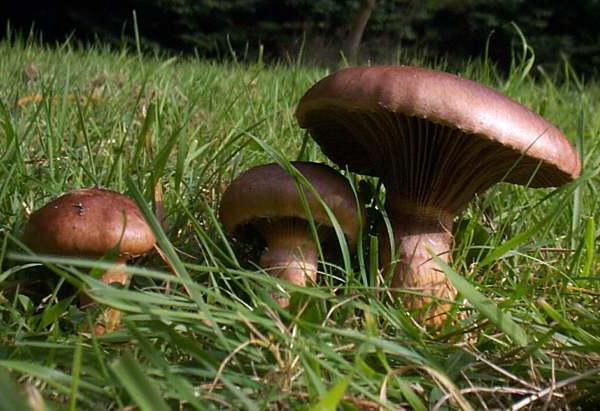

The use of wet fur for food
It is an absolutely edible mushroom filled with forest scents. Its rich taste will not leave indifferent any mushroom lover. Makruhi got their name from the fact that when cooked, their color changes to purple. When cooking, you should first clean the mucous skin from the mushroom and rinse it well, and then cook as you like. Of all the mushrooms, mokruha tastes the most like boletus.
You can cook all the same dishes from them as from ordinary mushrooms. Perfect for preparing pickles, you can make a delicious mushroom sauce or just fry as a side dish for meat or fish. There are many recipes for salads with the addition of various mushrooms, including mokruh. Due to the fact that they turn purple during heat treatment, all ready-made dishes with them in the composition will look unusual and memorable. For example, adding them to a salad will give you vibrant blotches of color in your dish, making it more appetizing.
Application
Representatives of this mushroom family are used not only for the preparation of all kinds of culinary dishes. They are widely used in cosmetology and folk medicine.
It is believed that mokruha has a beneficial effect on all organs of our body. The presence of antibacterial substances in this mushroom determines the effectiveness of its use as a therapeutic and prophylactic agent. Modern medicine confirms that mokruha is effective in treating viral diseases. In many countries, this mushroom is used to treat migraines, nervous system disorders, headaches and insomnia. It is assumed that such a product has a positive effect on the general condition of the body, helps to strengthen the immune system and is effective in combating chronic fatigue.
Cosmetics containing spruce moss mushroom (making such drugs at home will not be difficult) make the skin more elastic and silky. Lotions, infusions and decoctions relieve redness and inflammation. Along the way, they have a beneficial effect on skin color - it becomes even and matte. Moisture creams are recommended for those with oily skin prone to enlarged pores.
Decoctions and special masks from mokruha help strengthen and grow hair. After using these products, the hair becomes silky and shiny. Since ancient times, in folk medicine, this mushroom has been used to eliminate dandruff and split ends.


